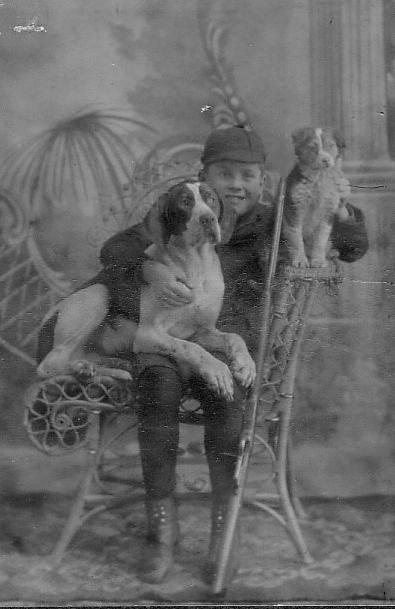
Children's Footwear: Boots

Figure 1.--A feature of boys' boots is especially obvious in this photo--the top lacing eyelets were actually strong outward facing hooks with the tops broad circular bent pieces. The boots are laced up in the lower eyelets then crossed back and forth over the hooks before being tied. This makes putting on and removing the boots much faster. You can tell where this Minnesota boy's heart was. The image is undated, but presumanly was taken about 1890.
|
|
A boot was traditionally a leather covering for the floor, normally reaching at least to mid-calf level. Rubberized boots appeared in the 20th century. Boys wear all kinds of different boots and boot-like footwear, such as cowboy boots galoshes, rubbers, snow boots, wellies, and others. Some like cowboy boots are very poular. Others like galoshes, boys hated to put on.
Description
A boot was traditionally a leather covering for the foot, normally covering not only the foot but also part of the leg. Many boots reached to mid-calf level. The heighth of boots varied greatly. Some were only slightly above the ankle. Others extended bove the knee. These very high boots were military boots and not worn by boys. Boots were normally made of leather. Rubberized boots appeared in the 20th century. Shoes in the late 19th and eraly 20th century were often high-topped, extending above the ankles. This makes it some what complicated in differentiating between shoes and boots.
Historical Developments
Boots are of ancientborigins. Leather boots were worn by both ancient Greeks and Romans. Boots were also worn in medieval Europe, but by people of some affluence. Any leather item was relatively expensive. The cocker was a high boot coming up the knee. Jack boots appeared in the 17th century and were commonly worn in the 18th century. Jack boots were made out of 'jack' or 'bend' leather. It was then waxed and hardened by coating it with boiling pitch. Jack boots were commonly used for riding and were adopted by the military. The Wellington boot appeared in the early 19th century, not to be confused with wellies. They were named aftervthe Duke of Wellington, but it was a stulecwidely worn by officers. Napoleon also wore them and they are also called Napoleon boots. Wellies are today called Wellington boots because they are high, shiny black boots.
Features
One feature of boys' boots was that the top lacing eyelets were actually strong outward facing hooks with the tops broad circular bent pieces. The boots are laced up in the lower eyelets then crossed back and forth over the hooks before being tied. This makes
putting on and removing the boots much faster. When fastening the boots, you take a lace in each hand, pull them tight, then pass them over the first pair of hooks and cross them over, then pass them over the next pair and cross them back and forth till you get to the top where you tie them.
Boys wear all kinds of different boots and boot-like footwear. Here are assessment is somewhat complicated that many boys in the late-19th and early 20 century wore boot-like shoes.
We note quite a range of different types such as cowboy boots galoshes, rubbers, snow boots, wellies, and others. Some like cowboy boots are very poular. Others like galoshes, boys hated to put on. Skinheads made Dr. Martins popular.
Country Trends
We do not yet have sufficient information on boots to develop information on country trends. American boys of course liked cowboy boots, but were not normally allowed to wear them to school. Some teenagers in the 1950s took to motorcycle boots. English boys were known for Wellies. Another Englkish style were Doc Martens. An English reader writes, "My grandfather always said that boys in his age (about the 1910s) wore boots (if they had shoes at all). So boys wearing boots was not a new thing in England. British reader writes, "Boots in boys sizes were quite a new thing as far as I was concerned in theclate 1960s. And they didn't last that long once schools banned them--but the Doctor Marten low-cut shoes came in then. I suppose years before (pre World War I) boots for boys were more common - when they worked, but as long as I can remember it was shoes or sandals (or plimpsoles for P.E.).- and then suddenly
younger boys wanted these boots. As I said this was when I was already in secondary school - yet the boots were so popular that even the boys who still wore shorts had them - which we laughed at. I must say though that wearing the boots out of school with cut-down Levis in Summer was not seen as too bad. I think, once again, it was the clash between trying to be a "rebel" yet still having to obey school and parental rules that made boots and school shorts seem so ridiculous. Wearing boots with sports shorts was probably not so bad either. It was
a really odd thing school uniform-- mainly because you didn't choose it but more than that too."
HBC

Navigate the Historic Boys' Clothing Web Site:
[Return to the Main footwear page]
[Introduction]
[Activities]
[Biographies]
[Chronology]
[Clothing styles]
[Countries]
[Bibliographies]
[Contributions]
[FAQs]
[Glossaries]
[Satellite sites]
[Tools]
[Boys' Clothing Home]
Navigate the Historic Boys' Clothing Web chronological pages:
[The 1800s]
[The 1940s]
[The 1880s]
[The 1900s]
[The 1910s]
[The 1920s]
[The 1930s]
[The 1940s]
[The 1950s]
[The 1960s]
[The 1970s]
Navigate the Historic Boys' Clothing Web style pages:
[Skelton suits]
[Tunics]
[Eton suits]
[Kilts]
[Sailor suits]
[Knicker suits]
[Short pants suit]
[Long pants suits]
[School sandals]
Created: October 25, 2000
Last updated: 2:50 AM 6/14/2005



